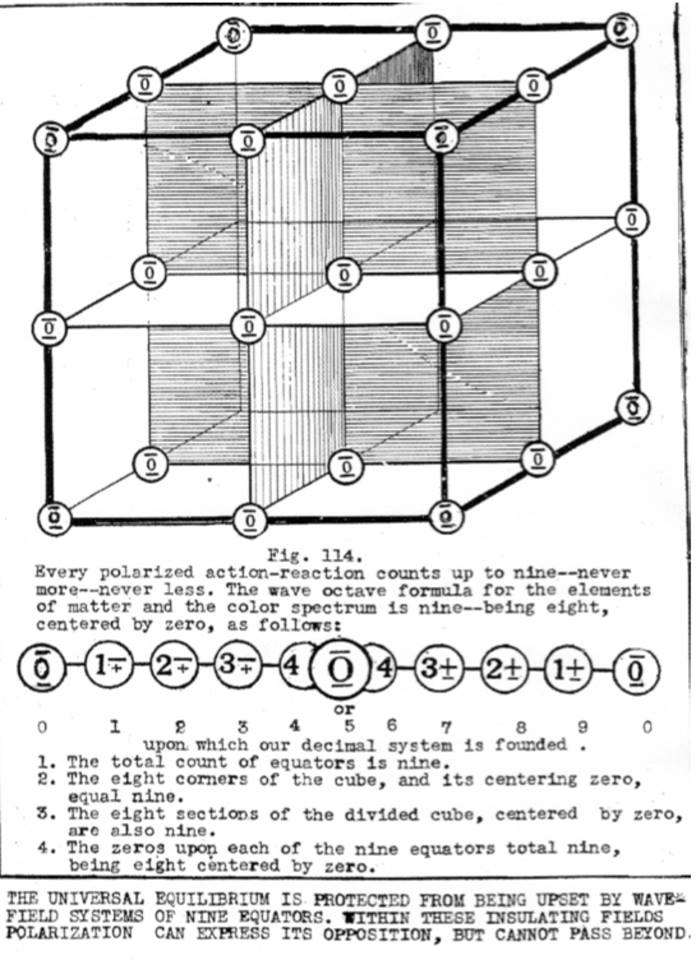| Nine | Nine |
noun: the cardinal number that is the sum of eight and one, three squared. adjective: denoting a quantity consisting of one more than eight and one less than ten
Keely
"In organ pipes, of a certain calibre, very sensitive waves occur at intervals; as according to the character of the sound evolved; but on a combination of resonators composed of brass tubes of more than nine in number, a wave of sound, induced by certain chords passing over them, produces high vortex action of the air enclosed in them. The vibration of tuning forks induces alternate condition of the air that surrounds them, if in open atmosphere; but quite a different action presents itself when the forks are exercised in resonating tubes, set to thirds of the mass chord they represent. Then high vortex action is the instant result. Vibrators cannot be set promiscuously in tubes, and get such results, any more than a musician can render a musical composition on the violin before tuning it." [Appendix I]
Russell
"And all that are three are nine - for all that are three are multiplied by three in this visible cube dominated universe of three dimensions." [Atomic Suicide, page 109]
"The formless zero universe is divided into four pairs of cubes and four pairs of spheres which are concentrically placed within each other. These four pairs of cube-spheres constitute one tonal octave of the universal harp. These tonal octaves are eight in number but appear to be nine for the first half of the ninth octave is the last of the first." [zero universe]
"Every polarized action-reaction counts up to nine – never more – never less. The wave octave formula for the elements of matter and the color spectrum is nine – being eight, centered by zero, as follows:

(courtesy University of Science and Philosophy) (click to enlarge)
upon which our decimal system is founded.
1. The total count of equators is nine.
2. The eight corners of the cube, and its centering zero, equal nine.
3. The eight sections of the divided cube, centered by zero, are also nine.
4. The zeros upon each of the nine equators total nine, being eight centered by zero. [Atomic Suicide, page 113]

(courtesy University of Science and Philosophy) (click to enlarge)
See Also
carbon octave wave
centering zero
Curved Wave Universe of Motion
octave pairs of rings
octave scale
octave tonal scale
octave tones
octave wave
One More Step Toward Building The Cube-Sphere Wave-Field
Wave Field
We Now Build the Nine Equators of Cube-Sphere Wave-Fields
Zero
Ramsay
Three times three are nine this would give nine notes; but as the top of the first chord serves for the root of the second one, and the top of the second for the root of the third, in this way these three chords of three notes each are formed from seven different notes. [Scientific Basis and Build of Music, page 96]
are always when they have returned to the side from which they were started. The Pendulographer, also, when writing the beautiful pictures which the musical ratios make when a pen is placed under the control of the pendulums, always finds his figure to begin again when the pendulums have finished their period, and have come for a fresh start to the side from which the period began. This confirms our author's definition of an oscillation of a pendulum. Fig. 3 is an illustration of the correct definition of a Musical Vibration, as also given in this work. Although the definition of an oscillation is not identical with that of a vibration, yet on account of their movement in the same ratios the one can be employed in illustration of the other as we have here done. Fig. 4 is a uniform rod suspended from the end as a pendulum; it will oscillate, of course, at a certain speed according to its length. In such a pendulum there are three centers related in an interesting way to the subject of Music in its three chords - subdominant, tonic, and dominant, which roots are F, C, and G. The center of gravity in the middle of the rod at 2, suspended at which the rod has no motion, corresponds to F, the root of the subdominant, in which there is the maximum of musical gravity. The center of oscillation at 3, which is one-third of the length of the rod from the end, is like the root of the tonic whose number is 3 in the genesis of the scale from F1. In this point of suspension the oscillations are the same as when suspended from the end at 1. The point at 9 is at a ninth from the center of oscillation. Our author discovered that, if suspended at this point, the pendulum had its highest rate of speed. Approaching the end, or approaching the center of oscillation from this point, the rate of speed decreases. Exactly at one-ninth from the center of oscillation, or two-ninths from the end, is this center of velocity, as Ramsay designated it; and it corresponds in some sort also to the root of the dominant G, which is 9 in the genesis of the scale from F1; its rate of vibration is nine times that of F1. The dominant chord is the one in which is the maximum of levity and motion in music. [Scientific Basis and Build of Music, page 105]
See Also
12.07 - Keelys Thirds Sixths and Ninths
14.02 - Three Six and Nine - The Principles of Creation
6.10 - Nineness of Cubes
clustered thirds
Figure 15.05 - Nine Pairs of Gravity Poles
ninths
Number
one-ninth
Sympsionics
The Russell Nine Octave Chart of the Elements
This Three Dimensional Cube Universe of Nine
wave octave formula
We Now Build the Nine Equators of Cube-Sphere Wave-Fields

